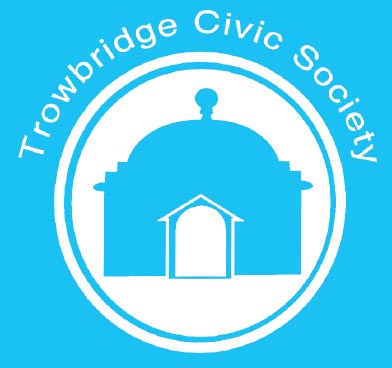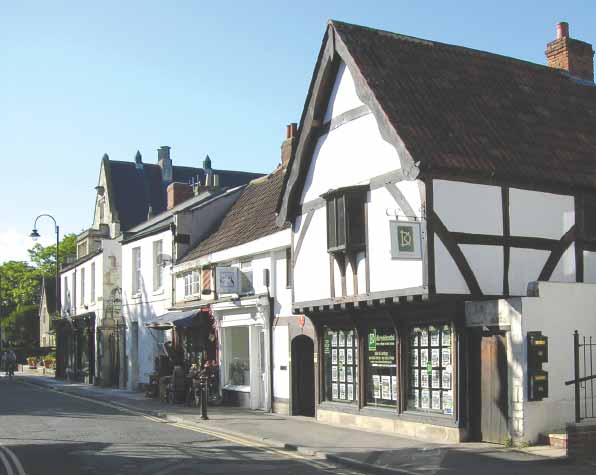| ||||||||||||||||||||||||||
Contents
Click on the item to go to the article. |
Editorial CommentWe are delighted that Peter and Jennifer Collier have joined the editorial group.
Deadline for copy for the autumn edition is Friday 16 September. |
Forthcoming Events
| 2011 | ||
| Date and Time | Event | Venue or Meeting Point |
| Saturday 2nd July 14:30 to 16:00 |
Cream Tea and Bring & Buy. By kind invitation of Dr & Mrs Eames | 30 Hilperton Road |
| Wednesday 3rd August Leaving approx 08:30 |
Coach trip to Poundbury and Dorchester | Click here for details |
| Thursday 8th - Sunday 11th September Various Times |
Heritage Open Day | Various sites open. Click here for more details. |
| Tuesday 11th October 19:30 |
“GLEANINGS FROM WILTSHIRE RECORDS” - Talk by Steve Hobbs | Haden Room, United Church, Church Street, Trowbridge. |
| Tuesday 15th November 19:30 |
PUBLIC LECTURE “A History of Trowbridge Pubs” by Ken Rogers |
Haden Room, United Church, Church Street, Trowbridge. |
To arrange for a lift or to volunteer to car share please contact Glyn on 755784
FROM THE CHAIRMAN
Members may or may not have heard of a new group in Trowbridge called ‘Campaign for a better Trowbridge’. I recently met Ken McCall, a member of the group, and his letter in the April 1st edition of the Wiltshire Times clearly expresses the group's views.
For too long the people of Trowbridge and villages have seen planners neglect the town centre while allowing developers to cover more green fields with housing estates and business parks, all this, while the centre of town stagnates. At last, the people of Trowbridge and villages have a choice and we are delighted. Trowbridge offers so many opportunities - it has very many brown field sites to build on, old buildings to convert, industrial areas to modernise. It has many beautiful and historic buildings which are hidden gems of the town, also some excellent new developments in Bradford Road, and the flats on the corner of Timbrell Street and Prospect Place. It has a station with excellent rail services to many parts of Wiltshire, Bath, Bristol and more.
Campaign for a better Trowbridge looks forward, at last to a development plan in the form of the Core Strategy and Local Development Framework that builds and renovates the town centre with offices, shops, education and other activities in the town, and that says once and for all a resounding ‘NO’ to just adding more urban sprawl with the idea that ‘bigger is better’, when it's not! In the case of Trowbridge, the sprawling expansion just hasn't worked. Many of us want a County Town and not another Swindon. Trowbridge could suffer with having more growth than anywhere else in the West Country, if we are not careful, so we would like to ask Wiltshire Council to assure us there will be an option within the Core Strategy for ‘low growth’.
In wanting a better Trowbridge we would certainly agree with Ken McCall and hopefully we will be able to work with his group in the future. The Civic Society has been working for ‘a better Trowbridge’ since the CATIRR campaign in 1978. Some of our members may not be aware of the Campaign Against Trowbridge Inner Relief Road, it was from this group that the Civic Society was formed. Some good news, I hear that Newland Homes are looking at the old Ushers bottling site next to Sainsburys, a sign that things are not completely at a standstill in the town despite the current economic situation. We shall have to monitor carefully the house types on this very important town centre site if they decide to build.
Planning Matters
You will be aware that our Town Hall has temporary railings where stone fell recently. Wiltshire Council has applied for Listed Building Consent to repair the stonework. R H Tomlinssons Ltd was again refused permission to demolish toilets and garage block and build an accommodation unit at the rear of the Rose and Crown, Stallard Street. It was up for sale by auction and currently has a sign on the scaffolding saying ‘now recruiting staff’. The Motor Supplies' shop, 1a Gloucester Road has permission to redevelop into residential apartments. Zion Baptist Chapel, Union Street has successfully applied to fit solar panels to the rear roofing and replace guttering using materials suitable to a listed building. Sainsbury's seem to be trading well, as they wish to expand into empty units, but have been refused permission for deliveries between 23.00 and 07.00 hours. HSBC, Fore Street, need to improve their security with railings, gate, floodlights and camera at the rear.
The Paddocks, Hilperton Road wish to demolish and rebuild it as a 66 bed Care Home that will meet current Quality Care Commission standards. They had permission for a 60 bed unit, but that had lapsed. Following regular pre-application discussions with planning department officers, this new proposal shows great care has been taken to limit its impact on the two schools and housing in the Ashton Street area and Hilperton Road, although not visible from there. Design materials take account of the very different architecture in those areas. There is no doubt that there is a need now, and even more in the future, for homes that enable staff to provide care in an environment that enhances privacy, dignity and individuality for those in the latter years of life.
URGENT APPEAL: Margaret Howard needs help in reviewing planning applications - the most vital and interesting of our remits - internet access required. Kay Austin, treasurer, needs a ‘shadow’ to understudy during any absence.
E J SHANLEY AND SON Their good works
Most of our developers and substantial property owners are not local and not surprisingly appear to have little interest in our feelings and aspirations. Thankfully E J Shanley and Son couldn't be more different and it has saved, renovated and restored many of our significant buildings.
Let us take a short walk from the top of Church Street (once Back Street) to Hill Street, via the now truncated Back Street, with a small detour in Union Street. We start at the former Co-operative retail complex which has had its stonework beautifully cleaned and restored and the ground floor, for a while, again traded as a furniture shop. It has now reopened as a Polish Deli. Above is Contender Gym and Fitness Studio - the training base for our new English middle weight boxing champion, Nick Blackwell.
On the opposite side of the road 9 and 9A Church Street, one of the oldest buildings in Trowbridge, was reconstructed in 2002/3 to create the half-timbered, jettied house as it would have appeared centuries before. Now called The Hall, and occupied by DK Estate Agents, this gem well deserved its Town Council Civic Enhancement Award in 2003. Note the orange plaque. Just a little further down on the same side Emmanuel Church (formerly the 18th century Back Street Chapel) became redundant quite recently and the whole complex has been renovated. The main area, now called Wicker Court, houses North Wessex Training. The internal monuments have been protected behind screens. For many years the four Emmanuel cottages at the rear were empty but are now restored and occupied.
Turning into Union Street we come to the stately former St James's Church hall. For many years this was used for a variety of furniture retailers and became rather shop soiled. The interior was transformed to once again reveal the magnificent southeast rose window. Outside, much of the badly weathered stonework was renovated and subsequently the building has been used as a gym and fitness centre. In 2005 it too gained the council's Enhancement Award (another orange plaque). Going on to Back Street and passing the exciting looking Brewery facade we come to Hill Street and the County Council Offices
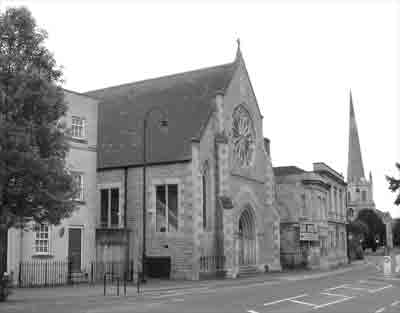 building of 1915. This is the only mainly brick building on our tour and it housed the town library for many years from the late 1950s. In recent times it has been home to sports and entertainment clubs. When this restoration and conversion to 16 apartments is completed it will be another of the company's landmark buildings.
building of 1915. This is the only mainly brick building on our tour and it housed the town library for many years from the late 1950s. In recent times it has been home to sports and entertainment clubs. When this restoration and conversion to 16 apartments is completed it will be another of the company's landmark buildings.
Away from our walk are two other sites in the portfolio. The brick block occupying the rectangle bordered by Court Street, Mill Street and Castle Street comprises Kestrel House and Court Mill House. The latter was a factory, belonging to the Castle Court Mill complex, which in 1836 contained only spinning jennies. Kestrel house, which includes the excellent Cafe Italiano and several other outlets, is on the site of the Art Deco Barnes's and Dennis's Garage which became Newbury's Antiques. A more recent acquisition is Homefield House in Polebarn Road. The older part (later renamed Rosefield House) was home to the Haden family and the modern extension (used for various government offices) is now refurbished and available for office letting.
Better known perhaps for the scrap metal business in Shails Lane, E J Shanley and Son Ltd deserves to be widely acknowledged for its interest in preserving, improving and finding uses for many of our fine old buildings, which in most cases have outlived their original purpose.
I am grateful to Antoinette Pullen of Upsalls Property Management and Terry Shanley for their help in producing this article.
THE KINGS ARMS (Part 2)
Following the article in the last Newsletter, it should be noted that all the inn signs seen on the building have not had an apostrophe although it has been used in advertisements and directories; until about 1930 the projecting pub sign read ‘The Kings Arms Inn’ after which the word ‘Inn’ was deleted. In 1896 the new proprietor was Mr U Webb who was pleased to announce that he supplied ‘wines and spirits of the best quality, beers and finest ales and all kinds of tobacco and cigars’. He had stabling accommodation for the convenience of gentlemen attending the Market. This was probably where the toilets are now located.
Although for nearly a hundred years the right hand side was a retail shop,it is not known when independent retailing commenced but it could have been from 1886 when Mr R Titt, opened a branch of his picture frame manufacturing business at ‘next door to the King's Arms’. The site almost certainly was the right hand side as you look at the building and may from this time have had a small window and a door in the extreme right. This is where the extractor fan is today and a horizontal crack in the plaster probably marks the position of the top of the door. The inn used the door in the centre of the total frontage, the left hand side of the ground floor and the left and centre of the first floor with possibly, following examination of the curtains in photographs, the retail business having access to the floor above. After a few years Edward Archard was occupying the premises in the same line of business.
In 1894 and 1895 George Mouland, who owned The Temperance Hotel in Wicker Hill, conducted a business of commission agent for veterinary products to be followed from July 1895 by W H Kingman from Bath who came to sell boots and shoes. This frequent change in occupiers ceased in 1896 when George Stokes opened as G Stokes and Son selling zinc, iron and tinplate articles. He also fitted incandescent lights, hung bells, of the type to tell domestic staff in which room their services were required, and was a gas fitter. (He lived at both 44 West Street and 11 Pilewell,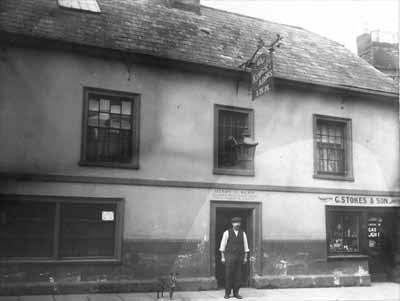 where orders could be left, and occupied premises opposite at 71 Castle Street (in the premises of H J Knee) where he had taken over the ironmongery business of James Beaven.) His wife was a milliner. Initially he had the words ‘G Stokes’ and probably ‘& Son’ painted over the window and door but after a few years when Henry G Bush was the landlord, the complete front was repainted thus deleting the words ‘Ushers Noted Ales and Stouts’. George Stokes had painted above his window the words ‘tinsmith and gasfitter’ in addition to his business name. In 1933 George Stokes ceased trading and from then until 1936 Jimmy James conducted his business of wireless engineer, radio receivers and cycles in the name of ‘Trowbridge Wireless and Cycle Exchange’.
where orders could be left, and occupied premises opposite at 71 Castle Street (in the premises of H J Knee) where he had taken over the ironmongery business of James Beaven.) His wife was a milliner. Initially he had the words ‘G Stokes’ and probably ‘& Son’ painted over the window and door but after a few years when Henry G Bush was the landlord, the complete front was repainted thus deleting the words ‘Ushers Noted Ales and Stouts’. George Stokes had painted above his window the words ‘tinsmith and gasfitter’ in addition to his business name. In 1933 George Stokes ceased trading and from then until 1936 Jimmy James conducted his business of wireless engineer, radio receivers and cycles in the name of ‘Trowbridge Wireless and Cycle Exchange’.
John Brewer opened as ‘J Brewer and Sons’ bakers and confectioners in 1936 and probably before opening had the shop refurbished and fitted a larger window and door. From 1956 the fascia read ‘J Brewer and Sons Ltd’. From 1943 to 1973 the bakery was at 14 Hill Street from where Michael Brewer would bring freshly baked products to the shop. In the spring of 1970 the business moved to 51 Fore Street and the retail part of The Kings Arms was rebuilt to open on 7 August as a double fronted public house with new windows to resemble the original appearance of the building.
Michael Lefever undertook major restoration work on acquiring the premises in Feb 2010 and opened as a public house at 4pm on 19 August 2010, with a new kitchen commencing food preparation the next day.
AVENUE ROAD A brief history
The Wiltshire Council Community History site has this to say about the road I live in: “A better class of suburb had appeared along the Hilperton Road from the 1790s to the later 19th century and Victoria Road was built in 1860. A little below this in standard were the houses of Wingfield Road and West Ashton Road, while for the rather less wealthy there was the villa type housing of Westbourne Road (1870s) and Avenue and Clarendon Roads (1890s)”. Although built for the “less wealthy”, Westbourne Road and Avenue Road were considerably smartened up by the addition of trees on both sides of the road, and the houses were given names, only two or three of which still are visible today. Those in Avenue Road included Eglantine, Sunnyside, Tintagel, Lexington, Plas Newydd and Greta Villa. The 1899 OS map of Trowbridge shows the western side of Avenue Road full of houses, while the eastern side has 8 houses at the southern end and 5 at the northern end. In the middle of is a gap marked Allotment Gardens. This is where our house lies and when we first moved in in the 70s there were two apple trees and a pear tree in our garden, remnants of the allotments. According to our deeds the land was known as part of Tyning or Lower Tyning and planning permission was applied for by a Mr Crook, a local builder. The land had been bought from the Trowbridge Urban District Council by Frederick Beer for £155 and a mortgage was taken out for the house in 1903. Mr Beer was secretary of the Pioneer Friendly Society and he died in 1963 though whether he had been living here all that time is unknown as he died in Clarendon Road. (It took a while to find him on Ancestry.co.uk because his name has been transcribed as Mr Been!)
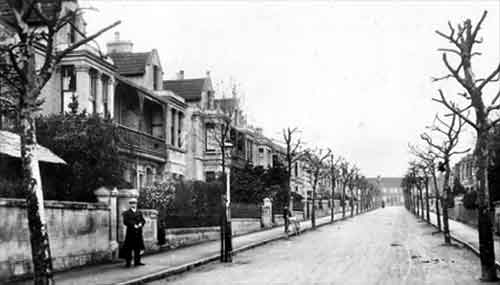 By the 1911 census most of the houses had been built, though numbers 14 and 16 were not constructed until the beginning of the 1930s and their different style makes this obvious. Most of the houses are semidetached, though some on the western side are terraced. There is also one detached house. The houses on the east side, closer to Wingfield Road (originally known as London Bridge Lane on the house deeds) are larger and grander, some with balconies. So who were the “rather less wealthy” who lived here during the first part of the twentieth century? There was quite a mixture as one would expect and some of the inhabitants seemed rather “more wealthy” than we might expect from the quote at the beginning of this piece. During the first few years of the 20th century there were, at one time, five railway workers and 6 school teachers. Other residents included a plumber, caretaker of the High School, a tailor, journalist, farmer, post office clerk and woollen worker. Some of the smaller houses must have been cramped. At number 2 lived Lucy Lucas, a widow, with her 9 children, while just a few doors down were a railway guard and his wife, 4 sons and a boarder. There were also some residents from what might be termed a higher social class - a railway bookstall manager and a manager of a bedding factory, a chemist, Wesleyan and Baptist ministers, curate of Holy Trinity and the Organising Secretary of the County Agricultural Committee. In the biggest house, 54, which has now been converted into flats Ellen Hobbs, “living on her own means”, had a companion and two servants, while just a couple of doors up lived John Peter Hamilton Boileau (1841-1910) with his wife and two servants. He had been an army surgeon, becoming a lieutenant colonel in 1884 and brigade surgeon in 1889. He retired in 1889 from Bengal and lived in Avenue Road as “Medical Officer in charge of Troops”. The house next door was a lodging house and opposite, in a big house, lived a superintendent minister of the Methodist church.
By the 1911 census most of the houses had been built, though numbers 14 and 16 were not constructed until the beginning of the 1930s and their different style makes this obvious. Most of the houses are semidetached, though some on the western side are terraced. There is also one detached house. The houses on the east side, closer to Wingfield Road (originally known as London Bridge Lane on the house deeds) are larger and grander, some with balconies. So who were the “rather less wealthy” who lived here during the first part of the twentieth century? There was quite a mixture as one would expect and some of the inhabitants seemed rather “more wealthy” than we might expect from the quote at the beginning of this piece. During the first few years of the 20th century there were, at one time, five railway workers and 6 school teachers. Other residents included a plumber, caretaker of the High School, a tailor, journalist, farmer, post office clerk and woollen worker. Some of the smaller houses must have been cramped. At number 2 lived Lucy Lucas, a widow, with her 9 children, while just a few doors down were a railway guard and his wife, 4 sons and a boarder. There were also some residents from what might be termed a higher social class - a railway bookstall manager and a manager of a bedding factory, a chemist, Wesleyan and Baptist ministers, curate of Holy Trinity and the Organising Secretary of the County Agricultural Committee. In the biggest house, 54, which has now been converted into flats Ellen Hobbs, “living on her own means”, had a companion and two servants, while just a couple of doors up lived John Peter Hamilton Boileau (1841-1910) with his wife and two servants. He had been an army surgeon, becoming a lieutenant colonel in 1884 and brigade surgeon in 1889. He retired in 1889 from Bengal and lived in Avenue Road as “Medical Officer in charge of Troops”. The house next door was a lodging house and opposite, in a big house, lived a superintendent minister of the Methodist church.
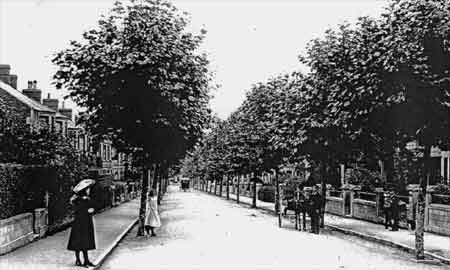 This mix continues over the years, with clerks and engine drivers, a GWR detective and a costumier, as well as headmaster of Trinity Boys' School and a music teacher. At one time William Pullinger, director of education 1903-31 at County Hall, lived in this road. By 1940 number 54, partly facing Wingfield Road, had become the St John of God Convent. In 1948 it became the precursor of St Augustine's School which moved to its present site in 1951. Today the London plane trees are sometimes a curse for motorists trying to find a parking place as only a few of the houses have drives, but they make this road, along with Westbourne Road, one of the more distinctive roads in the town.
This mix continues over the years, with clerks and engine drivers, a GWR detective and a costumier, as well as headmaster of Trinity Boys' School and a music teacher. At one time William Pullinger, director of education 1903-31 at County Hall, lived in this road. By 1940 number 54, partly facing Wingfield Road, had become the St John of God Convent. In 1948 it became the precursor of St Augustine's School which moved to its present site in 1951. Today the London plane trees are sometimes a curse for motorists trying to find a parking place as only a few of the houses have drives, but they make this road, along with Westbourne Road, one of the more distinctive roads in the town.
<h1 style=“font-weight: bold;”>The Civic Society Website</h1>So what are the hieroglyphics in the title? This article explains a bit of the background to the Civic Society web site. Web sites use a language called HTML (Hypertext Mark-up Language) to format the layout and text. This governs absolutely everything such as tables, lists, paragraphs etc. as well as the basics like underlining and font styling. So the title line shows the HTML tags that might be used to format a heading on a web page. Soon after my wife and I moved down from West London, we started to look about to see what was of interest. At one of the West Wiltshire shows, we spotted the Civic Society stand in the Trowbridge tent. We took a membership form and went away to investigate the Society before joining. It was almost impossible to find out anything about the Society, as there very little on the web. We subsequently joined, and I became a committee member with the intention of publicising the Society via a web site. Initially, the committee purchased our web address (www.trowbridgecivicsociety.org.uk) and directed it to a facility set up by the Wiltshire Times, which gave non-profit organisations a web site for free. After a while this became a little restrictive, so we moved to a purpose-built site where we are able to customise our content. This worked well for a number of years and was expanded to provide contact pages, a copy of the newsletter etc. It also allowed us to highlight forthcoming events using techniques like a scrolling banner. Last January, I decided the site needed a re-vamp, so I used a new style and expanded the content to include a page of museum news. Any suggestions from Society members for additional content on the web site would be most welcome. |
 The Story of
The Story of
St James's
Parochial School,
Trowbridge
There is a record of 1484 which states that there was a parochial choir at St James's church in Trowbridge and it is probable that the choristers (boys) were also given a basic education in reading. But the first definite mention of a “proper” school connected to the church is in the Vestry Minute Book. This refers, in 1667, to a Free School built in the churchyard, supported by benefactors who wished to provide education for poor children. One of these was James Singer who left money in his will for the education of “ten poor boys” to be taught the doctrine of the Church of England, reading, writing and arithmetic. According to a report of 1834 there was a large school house which had been erected “a century past, on land which now forms part of the churchyard.”
In 1783 the rector states that “the money given at the offertory” was used “by the churchwardens for the use of the Free School” which was said to be “supported by the settled endowment for 20 boys and girls who were to be taught to write and regularly instructed in the principles of the Christian religion according to the Church Liturgy and are catechised on prayer during Lent”.
In 1812 the rector of St James's Church, the Rev Gilbert Beresford, wished to establish a large school on the National System. This was the system of education put forward by the National School Society which was formed in 1811 by Dr Andrew Bell, a minister of the Church of England. Bell's method was called the Madras system (originating in India) and is a variant of the “monitorial” system. The Lord Bishop of Salisbury agreed with the proposal and it was decided that “a school for Boys and a school for Girls be established in the town of Trowbridge for the united purpose of educating the children of parents of all denominations who shall be willing to send them and for instructing future teachers of other parishes.”
 |
| 1922-23 Editor's mother, Grace Marsden (née Rogers) back row second from left, aged 9. Teacher, Miss Elsie Jones. |
In the 1840s the Rev Hastings saw the need to improve on the existing schools. The population of Trowbridge was now 11,000 and the parish of St James only had the  Free School. The girls' school was in the district of Holy Trinity. It was decided to build a new school and put all the departments on the site of the Three Tuns in Back Street (now Church
Street). It was completed in January 1846. The Society contributed £500 and a government grant of £726 was obtained from the Committee of Council on Education. The rest of the total needed of £2770 was paid for by voluntary subscriptions. This is the building that still stands in Church Street. At first there were 150 boys and girls in the main school and 136 in the infants' department. At last the National School was established. By 1857 there were over 500 boys and girls being taught in the school and in 1864 the Rev Hastings decided to build an infants' school in the grounds of the church. It closed in 1890 and is now the Upper Vestry. In 1886 the Rev Trotter enlarged the school so that there was said
to be room for 900 children. By this time there were several National Schools in the town and Wiltshire was one of the three
counties with the highest proportion of public week-day scholars to total population. Thanks to the church, which believed that the duty of educating the people was first and foremost a religious one, the school was now firmly established. The Elementary Education Act of 1870 allowed local authorities to set up their own schools if there was not sufficient local provision. In Trowbridge there was not quite sufficient so St Thomas's Infant National School was set up and opened in 1872. In 1880 an act was passed making it compulsory for all children up to the age of 10 to attend school. In 1883 the girls' school became the Trowbridge Parochial Girls' School but the boys' school was known as the National School until 1901 when it was changed to Parochial Boys' School.
Free School. The girls' school was in the district of Holy Trinity. It was decided to build a new school and put all the departments on the site of the Three Tuns in Back Street (now Church
Street). It was completed in January 1846. The Society contributed £500 and a government grant of £726 was obtained from the Committee of Council on Education. The rest of the total needed of £2770 was paid for by voluntary subscriptions. This is the building that still stands in Church Street. At first there were 150 boys and girls in the main school and 136 in the infants' department. At last the National School was established. By 1857 there were over 500 boys and girls being taught in the school and in 1864 the Rev Hastings decided to build an infants' school in the grounds of the church. It closed in 1890 and is now the Upper Vestry. In 1886 the Rev Trotter enlarged the school so that there was said
to be room for 900 children. By this time there were several National Schools in the town and Wiltshire was one of the three
counties with the highest proportion of public week-day scholars to total population. Thanks to the church, which believed that the duty of educating the people was first and foremost a religious one, the school was now firmly established. The Elementary Education Act of 1870 allowed local authorities to set up their own schools if there was not sufficient local provision. In Trowbridge there was not quite sufficient so St Thomas's Infant National School was set up and opened in 1872. In 1880 an act was passed making it compulsory for all children up to the age of 10 to attend school. In 1883 the girls' school became the Trowbridge Parochial Girls' School but the boys' school was known as the National School until 1901 when it was changed to Parochial Boys' School.
The 1902 Education Act reorganised education so that the county boroughs and counties took over responsibility for all branches of education. In the next few years the Church Street school had many improvements made - new floor, fresh air inlets in the walls and roof, new desks, playground repaired, new harmonium. In 1907 a new back cloakroom was built and a year later a wooden staircase for the infants was installed. The school was completely reorganised in 1923. Girls from the Trinity site were transferred to the boys' site, some boys moved to Trinity Boys' and Infants' School in Park Street (opened in 1873) and others went to Adcroft Boys' School which became the senior school from 1931 to 1940. The girls now occupied the top floor of the school and the infants the ground floor. After the Hadow Report (1921), Parochial School was reorganised again in 1931 as a Junior Mixed School. St Thomas's Infants school, the only other Church of England school, was closed and these children, along with infants from Parochial were moved to Margaret Stancombe School. This had been built in 1893 as The Margaret Stancomb Memorial Infants' School and had opened on February 19th 1894. The Parochial School opened with 373 on roll although there was supposed to be accommodation for 290. Electric lights were installed in 1936 along with improved sanitation and ventilation. During the war numbers were swollen for a time by children from London. After the war, school life went on in the same inadequate building, no staff room and classes separated by wooden partitions. However, PE was now possible in the Tabernacle church. In 1949, Parochial became a ‘controlled’ school, which meant that the local authority met all the school's expenses. As numbers increased it became necessary to hire two classrooms in the Baptist Church and one in the Tabernacle Church. Finally a new school opened in 1967 on its present site. Parochial was now the only Church of England school in Trowbridge, having close connections with both St James's Church and St Thomas's Church.
On the first of January 2008 Margaret Stancomb Infant School amalgamated with the Parochial Junior School to become the Bellefield Primary School. The St James's Parochial School name finally disappeared.
School building photographs courtesy of The Trowbridge Museum.
RECENT MEETINGS |
AGM Tuesday 15th March 2011
In the absence of the Chairman, Glyn Bridges, at a Town Council Meeting, Margaret Howard as Vice Chairman, welcomed over fifty members to the Annual General Meeting. Apologies were received from seven members.
During the brief business meeting Glyn Bridges was re-elected as Chairman with Kay Austin as Treasurer and Celia Russell as Secretary. Margaret Howard appealed for a volunteer to shadow the Treasurer in order that someone else would understand the financial set up and also for someone to shadow herself in her role of checking planning applications. Members were asked to consider whether they have unused skills. The Executive Committee members, Peter Bull, Kevin Hartley, Jonathan Hawkes, Margaret Howard, Diana Ingram and Diana King, were re-elected. Mr Patrick Andrews, who has been our auditor for some considerable time, kindly agreed to act as auditor for one further year during which time we will need to find someone else to take over from him.
Under the heading of ‘Any Other Business’ Margaret Howard said that members would be glad to know that a larger room (the Assembly Room) has been booked for January next year for our Social following over eighty people turning up to this year's social! The trip to Poundbury and Dorchester has proved to be very popular and the coach is now full with a waiting list. Jonathan Hawkes said we were still building our e-mail data base for mail shots etc. and members could give their details to Diana Ingram, the Membership Secretary, if they were happy to be contacted by e-mail.
After the AGM
Once the business of the AGM had been concluded and members were enjoying the usual homemade refreshments supplied by Ruth Bridges, there was unease amongst the committee members as the scheduled speaker - John Craig - had failed to show up. After a certain amount of panic a suggestion was put to Mrs Mary Pearce that perhaps she could follow up her most interesting article in the last issue of the newsletter and expand it into a talk. Without hesitation she replied ‘Give me a few moments to get my thoughts together and I'll be happy to do so’. What an interesting, lively, informative and at times amusing talk it proved to be. As in her article she started at the beginning with her birth in Keevil and took us through her school days at Miss Lansdown's school followed by Trowbridge Girls' High School. She spoke of joining the staff at Miss Lansdown's Hilperton Road School, moving it to The Halve and finally brought us to the present day in Courtfield House. She spoke warmly of her late husband Bernard and the support he had given her. She told us of life on the council and how as a member of the Housing Committee she came across, for the first time, people in great need. This experience made a big impact on her life. She ended with a rallying call to the membership to fight for the town, ‘It is a good town and there is lots worth coming to Trowbridge for’.
This impromptu talk had the audience of over 50 riveted. Many asked questions and showed their appreciation to Mary. Thanks to Ruth for her coffee and biscuits and to Peter Bull for raising £40 on the raffle.
9 Roundstone Street
Following the Society's AGM Mrs Mary Pearce (née Ragbourne) gave a fascinating impromptu history lesson on Trowbridge as seen through her eyes. A few additional notes may add to the interest of those present and also for those unable to attend.
The origin of Roundstone School goes back to about 1910 when Miss Florence Lansdown of the Wiltshire Times family, opened a school in her house at 31 Stallard Street (in St Georges Terrace). In 1916 she moved her school to the first floor of 9 Roundstone Street (previously 2 Marlborough Buildings) and she lived on the second floor. This had been called Hilperton Road until renaming and renumbering in 1897 but presumably it was still being referred to unofficially as Hilperton Road as late as 1916 as Miss Lansdown named her school Hilperton Road School.
In 1939 ownership was transferred to Miss Dorothy Daisy Dainton who renamed the school Roundstone Preparatory School. She also lived on the second floor. The only toilet in the building was on the first floor. One of Miss Lansdown's pupils had been a Mary Ragbourne from Keevil who after the war returned to the school as a teacher under Miss Dainton. In March 1953 Miss Dainton retired moving to 17 West Ashton Road, and the school's new proprietor was Mary Ragbourne. To accommodate the ever increasing number of pupils the school took over the second floor.
At Christmas 1956 the school closed at 9 Roundstone Street and reopened in the January at 13 The Halve. When road widening plans were being developed a new home was required and the school moved to Courtfield House where it is still located.
Probably upstairs from 1880 until about 1894 was Henry Legg, a picture frame maker and Miss Legg, a teacher of pianoforte. They moved to 25 Fore Street where they had the benefit of a pavement access retail shop. By February 1883 Frank R C Brown had transferred his drapery and clothiers business from 1 Hill Street, a small shop, to the larger 9 Roundstone Street premises.
In August 1908 he sold the business to Henry Walter Godbold who sold ties, socks and aprons in addition to the normal range of drapery products. During the Great War, while Henry was in the services, his wife looked after the business which he ran until 1949. The trade was continued by Leonard Hughes Supplies Ltd who also sold rugs and ladies and gentlemen's wear. Their head office was in Wednesbury in the West Midlands. In 1956 they moved to 19 Stallard Street which they bought from Ushers Wiltshire Brewery Ltd and converted The Bell Inn to a retail shop, which in 2011 is occupied by Aston Interiors. The Bell Inn had been a J H & H Blake house before they were taken over by Ushers in 1922.
After the school had moved from Roundstone Street the premises appear to have remained empty, at least with regards to business activities, until 1959 when John Tily opened Pets Paradise. This trading name continued under six ownerships, three of which were John Tily. In 1975 it was renamed West Pet and with three owners it continued to sell pet products until 1982 when the new owner Sharon Draper renamed the shop West Pets & Aquatics. The last name change was in 1997 when Paul Powell renamed the shop Pet Care & Aquatics as is still the case. The ground floor has for nearly 130 years been occupied by retailers in only two trade sectors - drapery and pet care.
Long-standing member's new publication MISSING, BELIEVED KILLED John Baxter has updated his earlier book ‘Not Much of a Picnic’ and the revised version ‘Missing,
Believed Killed’ was published in 2010 by Aurum, price £16.99, ISBN 978 1 84513 538 6. |
| Eds |
| Welcome to the following new members: | Corporate members: |
| Mrs Linda Huggins, Mrs Patience Morris, Mrs M Mundy, Mrs Mary Saunders, Mrs D Thornton. | Coleman' Family Dental Practice, Timbrell Street. The Trowbridge Museum. |
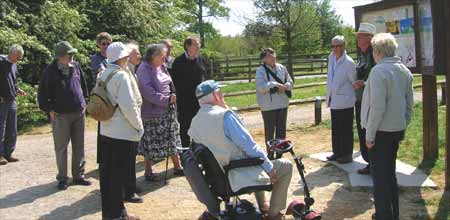
SOUTHWICK COUNTRY PARK Tuesday 3rd May 2011
A beautiful early spring day, with bright sunshine and a gentle breeze. Perfect conditions for our walk led by John Austin with assistance from Clem Maidment. Some of us were initially unsure, wasn't the park just a huge dog walking area? We soon found that this was not the case, and instead were shown what a tremendous range of wildlife this area supports. And, of course, all wildlife has connections with our own lives, whether social, historical, medical or culinary. We came upon a shady bank where English Bluebells flowered in company with white Greater Stitchwort and mauve Vetch. The banked up earth with a hedge, and an associated ditch suggest that this was an ancient boundary. Another indicator of the age of a hedge is Hooper's rule, where the greater number of species found in any particular stretch suggests a greater age - maybe 100 years per species of woody plant.
We also learned to distinguish between the highly poisonous Hemlock Water Dropwort and Garlic Mustard from whose leaves a tasty sauce can be prepared. As is often the case this plant has a special relationship with a certain insect, the Orange Tip butterfly. Overhead a variety of birdsong could be heard; Blackcap, Chiffchaff, Great Tit, Robin, Song Thrush, giving the sound so typical of an English spring. No wonder that the sheer beauty of the month of May has been celebrated by poets from Thomas Dekker (c. 1572 - 1632) to Wendy Cope, whose recently published ‘Family Values’ includes an excellent poem on the month of May. Even those of us who are not poets still found the walk most interesting and enjoyable.
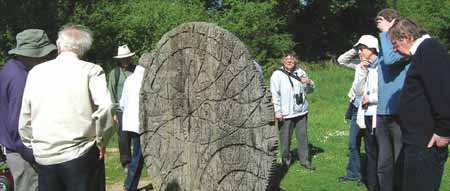 | |
| Members admiring Anthony Rogers' wooden sculpture made from French railway sleepers | |
